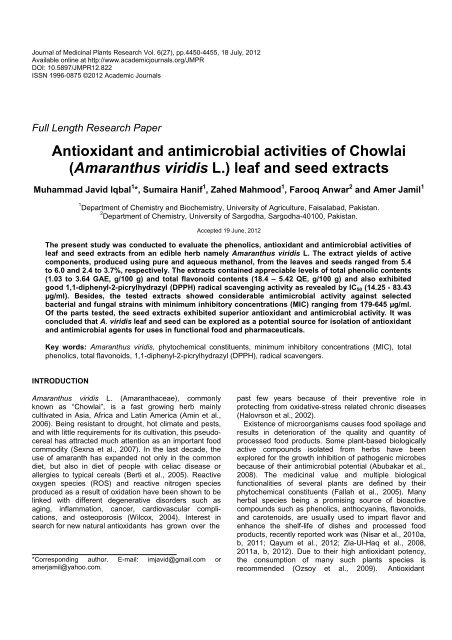Download Complete Issue (4740kb) - Academic Journals
Download Complete Issue (4740kb) - Academic Journals
Download Complete Issue (4740kb) - Academic Journals
Create successful ePaper yourself
Turn your PDF publications into a flip-book with our unique Google optimized e-Paper software.
Journal of Medicinal Plants Research Vol. 6(27), pp.4450-4455, 18 July, 2012<br />
Available online at http://www.academicjournals.org/JMPR<br />
DOI: 10.5897/JMPR12.822<br />
ISSN 1996-0875 ©2012 <strong>Academic</strong> <strong>Journals</strong><br />
Full Length Research Paper<br />
Antioxidant and antimicrobial activities of Chowlai<br />
(Amaranthus viridis L.) leaf and seed extracts<br />
Muhammad Javid Iqbal 1 *, Sumaira Hanif 1 , Zahed Mahmood 1 , Farooq Anwar 2 and Amer Jamil 1<br />
1 Department of Chemistry and Biochemistry, University of Agriculture, Faisalabad, Pakistan.<br />
2 Department of Chemistry, University of Sargodha, Sargodha-40100, Pakistan.<br />
Accepted 19 June, 2012<br />
The present study was conducted to evaluate the phenolics, antioxidant and antimicrobial activities of<br />
leaf and seed extracts from an edible herb namely Amaranthus viridis L. The extract yields of active<br />
components, produced using pure and aqueous methanol, from the leaves and seeds ranged from 5.4<br />
to 6.0 and 2.4 to 3.7%, respectively. The extracts contained appreciable levels of total phenolic contents<br />
(1.03 to 3.64 GAE, g/100 g) and total flavonoid contents (18.4 – 5.42 QE, g/100 g) and also exhibited<br />
good 1,1-diphenyl-2-picrylhydrazyl (DPPH) radical scavenging activity as revealed by IC50 (14.25 - 83.43<br />
µg/ml). Besides, the tested extracts showed considerable antimicrobial activity against selected<br />
bacterial and fungal strains with minimum inhibitory concentrations (MIC) ranging from 179-645 µg/ml.<br />
Of the parts tested, the seed extracts exhibited superior antioxidant and antimicrobial activity. It was<br />
concluded that A. viridis leaf and seed can be explored as a potential source for isolation of antioxidant<br />
and antimicrobial agents for uses in functional food and pharmaceuticals.<br />
Key words: Amaranthus viridis, phytochemical constituents, minimum inhibitory concentrations (MIC), total<br />
phenolics, total flavonoids, 1,1-diphenyl-2-picrylhydrazyl (DPPH), radical scavengers.<br />
INTRODUCTION<br />
Amaranthus viridis L. (Amaranthaceae), commonly<br />
known as “Chowlai”, is a fast growing herb mainly<br />
cultivated in Asia, Africa and Latin America (Amin et al.,<br />
2006). Being resistant to drought, hot climate and pests,<br />
and with little requirements for its cultivation, this pseudocereal<br />
has attracted much attention as an important food<br />
commodity (Sexna et al., 2007). In the last decade, the<br />
use of amaranth has expanded not only in the common<br />
diet, but also in diet of people with celiac disease or<br />
allergies to typical cereals (Berti et al., 2005). Reactive<br />
oxygen species (ROS) and reactive nitrogen species<br />
produced as a result of oxidation have been shown to be<br />
linked with different degenerative disorders such as<br />
aging, inflammation, cancer, cardiovascular complications,<br />
and osteoporosis (Wilcox, 2004). Interest in<br />
search for new natural antioxidants has grown over the<br />
*Corresponding author. E-mail: imjavid@gmail.com or<br />
amerjamil@yahoo.com.<br />
past few years because of their preventive role in<br />
protecting from oxidative-stress related chronic diseases<br />
(Halovrson et al., 2002).<br />
Existence of microorganisms causes food spoilage and<br />
results in deterioration of the quality and quantity of<br />
processed food products. Some plant-based biologically<br />
active compounds isolated from herbs have been<br />
explored for the growth inhibition of pathogenic microbes<br />
because of their antimicrobial potential (Abubakar et al.,<br />
2008). The medicinal value and multiple biological<br />
functionalities of several plants are defined by their<br />
phytochemical constituents (Fallah et al., 2005). Many<br />
herbal species being a promising source of bioactive<br />
compounds such as phenolics, anthocyanins, flavonoids,<br />
and carotenoids, are usually used to impart flavor and<br />
enhance the shelf-life of dishes and processed food<br />
products, recently reported work was (Nisar et al., 2010a,<br />
b, 2011; Qayum et al., 2012; Zia-Ul-Haq et al., 2008,<br />
2011a, b, 2012). Due to their high antioxidant potency,<br />
the consumption of many such plants species is<br />
recommended (Ozsoy et al., 2009). Antioxidant

















